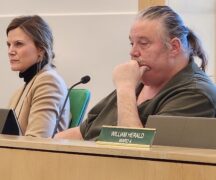By JAN McLAUGHLIN
BG Independent News
Bowling Green officials are being asked to consider possible green solutions to prevent street flooding.
With the increasing frequency of heavy rains, the city is wading through more standing water in streets, according to Jim Evans, a member of the committee that wrote the city’s Climate Action and Resiliency Improvement Plan. On Monday evening, Evans asked City Council to consider a holistic approach to stormwater drainage.
Evans, who retired after teaching geology for 32 years at Bowling Green State University, covered three aspects that can cause streets to flood after heavy rains:
- Design capacity of the stormwater system.
- Loss of design capacity due to the system aging or maintenance issues.
- Impact of climate change on design capacity.
Under the streets of Bowling Green, the stormwater system consists of a series of street drains, pipes, interceptors (where pipes join), underground filters, underground stormwater tunnels (where water is held temporarily), and outfalls.
The design capacity of stormwater systems is typically based on a five-year rainfall event. In Bowling Green, that is 1.68 inches per hour. Calculations indicate that during a five-year event there is a 20% chance that a rainstorm will meet or exceed the stormwater design capacity.
According to Evans, Bowling Green has seen 11 heavy rains so far this year – with two exceeding design capacity.
“As expected, on both days we had extensive street flooding in BG,” he said.
Evans pointed out that the actual capacity of a stormwater system is always less than its design capacity. Over time, partial or complete blockages occur due to debris and tree roots, or cracked and leaking pipes.
Climate change has created more problems. Warmer temperatures bring more moisture, heavy rainfalls have increased 24%, and the volume of water from the top 1% of storms has increased 42%, Evans said.
“What were statistically extreme events now happen more frequently,” he said.
The traditional engineering solution to preventing street flooding has been tearing up streets and replacing pipes. But that, Evans said, runs the risk of the project being obsolete even before completion.
Instead, Evans suggested Bowling Green consider using “green infrastructure.” He described two general types:
- Source area reduction focuses on putting less water into storm drains. That can be accomplished by the community using rain barrels, green roofs on businesses and apartment buildings to hold back rainwater, and rain gardens to capture run-off between downspouts and street drains. Stormwater can also be captured in the public right-of-way by installing bioswales, which prevent sediment and debris from entering storm drains and delay run-off. And permeable pavements could be helpful in parking lots or alleys.
- Water storage within the system would involve using detention basins, restored or constructed wetlands, or groundwater recharge basins. These could act as a final destination for stormwater or be a pathway stormwater follows on its route to the wastewater treatment plant.
Evans also suggested that Bowling Green consider reuse of stormwater.
“The new ‘One Water’ concept entails holding back some of the excessive rainwater to be repurposed for the intervening dry periods,” he said.
Stormwater is not suitable for drinking because as it flows down city streets it becomes polluted by oil, gasoline and asphalt compounds. But Evans explained that with simple filtration, stored stormwater could be used to fill needs such as emergency firefighting, to operate the sanitary sewer system during droughts, for irrigation, landscaping, golf courses, or for car washes.


